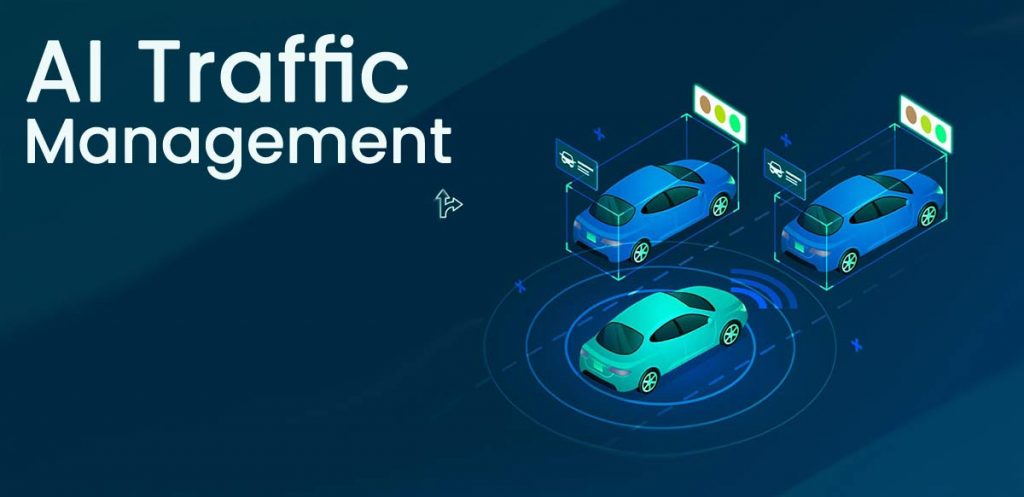AI in traffic management
- Road traffic management has changed dramatically with the rapid advancement of artificial intelligence (AI).
- AI accurately predicts and controls the flow of people, objects, vehicles, and goods at different points on the transportation network.
- By optimizing traffic flows across intersections and improving safety during periods when roads are closed due to construction or other events, artificial intelligence is providing better service to citizens than ever before and reducing accidents.
How Can AI Help In Traffic Management?
- Artificial intelligence can analyze real-time data from cars, buses, and trains to identify patterns that may indicate safety risks.
Coordinated Traffic Lights
- Traffic signal Management
- The goal of making traffic lights smarter has been to increase the efficiency of drivers.
- This will help in recognizing patterns in traffic to suggest alternatives, better urban design models, better fuel efficiency, better battery usage for EV’s shortening distances, and improve efficiencies along with sustainability.
Automatic Distance Recognition
- In automatic distance recognition (ADR), sensors such as lasers, radars, and cameras are used to detect the distance between a car and the objects around it.
Smarter Parking
- AI can identify congested areas ahead of time, enabling drivers to avoid traffic jams and save time during events such as concerts or big events
Better Route Planning
- AI-driven route planning across towns and countries can help us identify and use efficient, sustainable, and economically viable routes to help us get to our destinations
- This in the long term will help us improve supply chain management with complex distribution challenges and emergency management in smart cities.
Better Law Enforcement via AI
- With ITMS, offenders are automatically fined as per the law of the land, supported by evidence data in the form of snapshots & videos, as part of traffic management.
Is it possible to manage traffic intelligently?
- Intelligent Traffic Management System (ITMS) combines artificial intelligence with cameras installed at traffic intersections to detect and identify vehicles disobeying traffic rules and generate real-time alerts at the Central Command Center.
- Fines can be automatically imposed on offenders according to law and can be sent electronically to violators.
- An ITMS system can work in conjunction with the existing CCTV and traffic control system to provide a holistic solution to the current traffic menace.
How does AI benefit traffic management?
- Fluid traffic, with no traffic jams or domino effects, is good for the environment.
- Using AI and making smart decisions to improve efficiencies can help us deeply integrate sustainable strategies in traffic management.
- It helps improve the quality of air by reducing air pollution
- Ensures the optimization of supply chain management, such as last-mile deliveries
- The most frequent cause of accidents is human error
- All of these factors contribute to optimizing the entire traffic system
Quality data
- High-quality data is essential for these systems to function correctly and maintain road safety.
- A large part of the quality of the software designed for road traffic management is determined by the amount and quality of training data used.
- It is more likely that road traffic design will be safer if machine learning datasets are more reliable and realistic and driven by real-time ground data.
Using AI to manage traffic
- Some believe that AI can reduce congestion, improve fuel efficiency, and integrate sustainable strategies in traffic management, while some raise a vital point of privacy and tracking of vehicles that can lead to privacy invasion.
- AI can be applied in many different ways.
- Emergency vehicles can bypass traffic lights or other obstacles when responding to an emergency by using an emergency vehicle exemption.
- By prioritizing public transportation at critical intersections, transit signal priority improves overall travel times for passengers.
- IoT-based pedestrian safety systems are able to change crossing signals more quickly as soon as they cross the street.
AI Traffic Systems For A Smart City
- The smart city refers to a city that utilizes technology efficiently to provide citizens with services and benefits.
- These cities would be built using cutting-edge technology to offer services such as public transportation, traffic monitoring, and waste management to the government and citizens.
- Several methods are available to improve traffic behavior & avoid congestion.
Adaptive Traffic Control System (ATCS)
- Uses artificial intelligence to optimize the flow of vehicles in an urban environment
Autonomous Vehicles
- Automated vehicles are just one kind of automated vehicle
- Other types of automated vehicles include: Buses, Trains, and Commercial Aircraft
- There are advantages to automated vehicles compared to human-manned vehicles
- Reduce idling costs
- Improve fuel efficiency
- Improving road safety by using automated systems
Intelligent parking planning
- Using real-time data and building apps specializing in predictive analytics and event forecasting will help the cities create intelligent parking planning strategies.
Improved Traffic Flow
- Artificial intelligence can reduce traffic congestion by routing cars around congested areas
- Smart cameras can automatically identify pedestrians, cyclists, and cars at intersections.
- The overall traffic flow in the city is currently still managed by humans, but with the advent of AGI, these tasks can be automated.
Safety and Emergency Situations
- In emergencies, the authorities must be able to react quickly and efficiently to evolving situations to make sure everyone’s safe.
Transit Planning
- Intelligent Transportation Systems
- Using AI to plan public transit can help reduce travel times and traffic congestion drastically while increasing the effectiveness of buses, trains, and ferries.
Urban Planning
- Planned development and use of land, transportation systems, public facilities, and services such as water supply, waste management, and energy distribution
- For cities to plan effectively, they need accurate statistics on population size, demographics, employment trends, economic conditions, etc.
- Artificial intelligence and machine learning can help cities collect real-time data more efficiently and analyze it faster to identify critical patterns.
AI-Assisted Traffic Management Challenges
- Data acquisition and understanding the complexity of the data
Cyber Security Challenges
- Cyber security is an important issue that significantly impacts modern-day technologies that we depend on.
- Systems such as AI-based traffic management, primarily concerned with managing road traffic, are at risk of cyberattacks from hackers capable of causing significant damage.
Economic Questions
- As a result of AI-based traffic management systems, a city’s transportation department will save time and money and have a smaller environmental impact while drastically improving efficiencies.
- It also helps to improve the users’ quality of life, which is a huge positive for economic spending on such systems.
Ethical Considerations
- As a result of new technologies, many social questions regarding employment have arisen, but they also raise some concerns.
- Will those who have worked in the traditional transportation industry lose their jobs?
- If a machine can perform a task more efficiently and accurately than humans, what happens to those who used to do it?
Note:
- HTN, together with leading ADAS systems providers, aims at traffic systems facilitating the future mass mobility
- HTN addresses traffic flow dynamics and has developed novel traffic management systems yielding high lane capacities and low travel time on freeways and urban roads.
- HTN initiated its collaboration with the industry-leading standard provider, the Society of Automotive Engineers (SAE).



